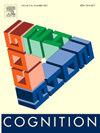Spatial and social cognition jointly determine multimodal demonstrative reference: Experimental evidence from Turkish and Spanish
IF 2.8
1区 心理学
Q1 PSYCHOLOGY, EXPERIMENTAL
引用次数: 0
Abstract
All languages in the world have demonstrative terms such as ‘this’ and ‘that’ in English, which have traditionally been treated as spatial words. Here we aim to provide experimental evidence that demonstrative choice is jointly determined by spatial considerations (e.g., whether the referent is near or far) and socio-cognitive factors (e.g., the listener's attention focus). We also test whether demonstrative choice varies depending on the speaker's use of pointing, to provide evidence for a multimodal account of demonstrative systems. We focus on the Turkish system and compare it with the Spanish one to better understand the cross-linguistic variability of 3-term demonstrative systems. Corpus studies have suggested that the Turkish proximal ‘bu’ and distal ‘o’ mark a spatial contrast between near and far space, whereas the medial ‘şu’ is used to direct the listener's attention to a new referent. Supporting this analysis, an online experiment using a picture-based demonstrative-choice task revealed that the medial form ‘şu’ was preferred when the listener was looking at the wrong object. The results of a second experiment using video stimuli further showed that the medial ‘şu’ was preferred when the speaker pointed to the referent to direct the listener's attention, whereas the proximal demonstrative was used in near space and the distal in far space, mostly in joint attention and without pointing. The results of a third experiment in Spanish showed radically different patterns of demonstrative-pointing use. The medial ‘ese’ was preferred in joint attention, whereas the proximal ‘este’ and distal ‘aquel’ were selected to direct the listener's attention towards the intended referent but without an effect of pointing. Our results confirm that demonstrative choice within a given system is determined by both spatial and socio-cognitive factors, interacting with pointing patterns and varying across languages. Leveraging recent experimental work in several languages, we interpret these findings as further evidence for the weighted parameters framework (e.g., referent position and listener attention), which explains demonstrative choice beyond previous categorical analyses.
空间认知和社会认知共同决定了多模态的示范参照:来自土耳其语和西班牙语的实验证据
世界上所有的语言都有指示性词汇,如英语中的“this”和“that”,它们传统上被视为空间词。在这里,我们的目的是提供实验证据,证明指示性选择是由空间因素(例如,指称物是近还是远)和社会认知因素(例如,听者的注意力焦点)共同决定的。我们还测试了指示选择是否会因说话人使用指向而变化,为指示系统的多模态解释提供证据。我们将重点放在土耳其语系统上,并将其与西班牙语系统进行比较,以更好地理解三词指示系统的跨语言变动性。语料库研究表明,土耳其语近端“bu”和远端“o”标志着远近空间的空间对比,而中间的“”用于引导听者的注意力到一个新的指称物上。为了支持这一分析,一项使用基于图片的示范选择任务的在线实验显示,当听者看错对象时,首选中间形式“”。第二个使用视频刺激的实验结果进一步表明,当说话者指向指称物以引导听者的注意力时,内侧的“”更受欢迎,而近端指示物用于近空间,远端指示物用于远空间,主要用于联合注意且不指向。用西班牙语做的第三个实验的结果显示了截然不同的指示用法模式。中间的“ese”是联合注意的首选,而近端“este”和远端“aquel”则被选择用于将听者的注意力引导到预期的指涉物上,但没有指向的效果。我们的研究结果证实,在给定的系统中,演示选择是由空间和社会认知因素共同决定的,与指向模式相互作用,并且在不同的语言中有所不同。利用最近在几种语言中的实验工作,我们将这些发现解释为加权参数框架(例如,参考位置和听众注意力)的进一步证据,这解释了超越先前分类分析的示范性选择。
本文章由计算机程序翻译,如有差异,请以英文原文为准。
求助全文
约1分钟内获得全文
求助全文
来源期刊

Cognition
PSYCHOLOGY, EXPERIMENTAL-
CiteScore
6.40
自引率
5.90%
发文量
283
期刊介绍:
Cognition is an international journal that publishes theoretical and experimental papers on the study of the mind. It covers a wide variety of subjects concerning all the different aspects of cognition, ranging from biological and experimental studies to formal analysis. Contributions from the fields of psychology, neuroscience, linguistics, computer science, mathematics, ethology and philosophy are welcome in this journal provided that they have some bearing on the functioning of the mind. In addition, the journal serves as a forum for discussion of social and political aspects of cognitive science.
 求助内容:
求助内容: 应助结果提醒方式:
应助结果提醒方式:


